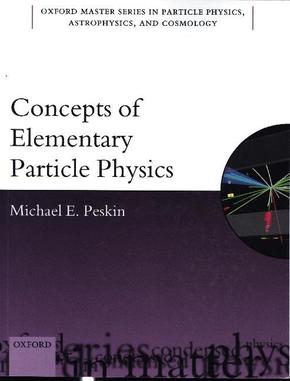Concepts of Elementary Particle Physics
| Verlag | Oxford University Press |
| Auflage | 2019 |
| Seiten | 400 |
| Format | 19,2 x 24,7 x 1,9 cm |
| Print PDF | |
| Gewicht | 814 g |
| Artikeltyp | Englisches Buch |
| Reihe | Oxford Master Series in Physics 26 |
| ISBN-10 | 0198812191 |
| EAN | 9780198812197 |
| Bestell-Nr | 19881219EA |
This particle physics textbook for senior undergraduates and early graduates explains the Standard Model of particle physics, both the theory and its experimental basis. The point of view is thoroughly modern. Theory relevant to the experiments is developed in detail but in a simplified way without needing full knowledge of quantum field theory.
The purpose of this textbook is to explain the Standard Model of particle physics to a student with an undergraduate preparation in physics. Today we can claim to have a fundamental picture of the strong and weak subnuclear forces. Through an interplay between theory and experiment, we have learned the basic equations through which these forces operate, and we have tested these equations against observations at particle accelerators. The story is beautiful and full of surprises. Using a simplified presentation that does not assume prior knowledge of quantum field theory, this book begins from basic concepts of special relativity and quantum mechanics, describes the key experiments that have clarified the structure of elementary particle interactions, introduces the crucial theoretical concepts, and builds up to the full description of elementary particle interactions as we know them today.
Inhaltsverzeichnis:
I Preliminaries and Tools
1: Introduction
2: Symmetries of Space-Time
3: Relativistic Wave Equations
4: The Hydrogen Atom and Positronium
5: The Quark Model
6: Detectors of Elementary Particles
7: Tools for Calculation
II The Strong Interaction
8: Electron-Positron Annihilation
9: Deep Inelastic Electron Scattering
10: The Gluon
11: Quantum Chromodynamics
12: Partons and Jets
13: QCD at Hadron Colliders
14: Chiral Symmetry
III The Weak Interaction
15: The Current-Current Model of the Weak Interaction
16: Gauge Theories with Spontaneous Symmetry Breaking
17: The W and Z Bosons
18: Quark Mixing Angles and Weak Decays
19: CP Violation
20: Neutrino Masses and Mixings
21: The Higgs Boson
22: Epilogue
Rezension:
I field tested this new textbook in a senior-level course that introduces advanced undergraduates to elementary particle physics before they have had the formal training in quantum field theory that is usually needed to rigorously present many aspects of the Standard Model. I say usually, because in his new book, Professor Peskin adeptly manages to avoid this prerequisite, in a comprehensive, modern, and unique exposition that is a welcome addition to teachers of the subject at this level. Christopher S. Hil, Department of Physics, Ohio State University

